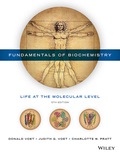
(a)
To calculate: The chemical potential difference at the given concentration values of Ca2+ when the membrane potential is -50mV.
Concept introduction: The free energy change for moving a substance across a membrane depends upon the concentrations on both sides of the membrane. In case of ions, the free energy change depends upon the membrane potential. A random distribution of molecules is an energy-rich condition because when all the concentrations are equal, the free energy change is minimized. The difference in the concentrations of the substances on both sides of the membrane produces a potential difference called the chemical potential difference. The difference in the charge trans-membrane movement of ions across the membrane is called
(b)
To calculate: The chemical potential difference at the given concentration values of Ca2+, when the membrane potential is -50mV.
Concept introduction: The free energy change for moving a substance across a membrane depends upon the concentrations on both sides of the membrane. In case of ions, the free energy change depends upon the membrane potential. A random distribution of molecules is an energy-rich condition because when all the concentrations are equal, the free energy change is minimized. The difference in the concentrations of the substances on both sides of the membrane produces a potential difference called the chemical potential difference. The difference in the charge trans-membrane movement of ions across the membrane is called electrochemical potential.
To explain: The comparison of both case (a) and case (b) and determine in which the movement of Ca2+ in the indicated direction is
Concept introduction: The free energy change for moving a substance across a membrane depends upon the concentrations on both sides of the membrane. In case of ions, the free energy change depends upon the membrane potential. A random distribution of molecules is an energy-rich condition because when all the concentrations are equal, the free energy change is minimized. The difference in the concentrations of the substances on both sides of the membrane produces a potential difference called the chemical potential difference. The difference in the charge trans-membrane movement of ions across the membrane is called electrochemical potential.
Want to see the full answer?
Check out a sample textbook solution
Chapter 10 Solutions
Fundamentals of Biochemistry: Life at the Molecular Level
 BiochemistryBiochemistryISBN:9781319114671Author:Lubert Stryer, Jeremy M. Berg, John L. Tymoczko, Gregory J. Gatto Jr.Publisher:W. H. Freeman
BiochemistryBiochemistryISBN:9781319114671Author:Lubert Stryer, Jeremy M. Berg, John L. Tymoczko, Gregory J. Gatto Jr.Publisher:W. H. Freeman Lehninger Principles of BiochemistryBiochemistryISBN:9781464126116Author:David L. Nelson, Michael M. CoxPublisher:W. H. Freeman
Lehninger Principles of BiochemistryBiochemistryISBN:9781464126116Author:David L. Nelson, Michael M. CoxPublisher:W. H. Freeman Fundamentals of Biochemistry: Life at the Molecul...BiochemistryISBN:9781118918401Author:Donald Voet, Judith G. Voet, Charlotte W. PrattPublisher:WILEY
Fundamentals of Biochemistry: Life at the Molecul...BiochemistryISBN:9781118918401Author:Donald Voet, Judith G. Voet, Charlotte W. PrattPublisher:WILEY BiochemistryBiochemistryISBN:9781305961135Author:Mary K. Campbell, Shawn O. Farrell, Owen M. McDougalPublisher:Cengage Learning
BiochemistryBiochemistryISBN:9781305961135Author:Mary K. Campbell, Shawn O. Farrell, Owen M. McDougalPublisher:Cengage Learning BiochemistryBiochemistryISBN:9781305577206Author:Reginald H. Garrett, Charles M. GrishamPublisher:Cengage Learning
BiochemistryBiochemistryISBN:9781305577206Author:Reginald H. Garrett, Charles M. GrishamPublisher:Cengage Learning Fundamentals of General, Organic, and Biological ...BiochemistryISBN:9780134015187Author:John E. McMurry, David S. Ballantine, Carl A. Hoeger, Virginia E. PetersonPublisher:PEARSON
Fundamentals of General, Organic, and Biological ...BiochemistryISBN:9780134015187Author:John E. McMurry, David S. Ballantine, Carl A. Hoeger, Virginia E. PetersonPublisher:PEARSON





